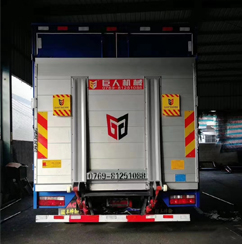
Adding hydraulic oil to the tailboard of a truck is a relatively simple but important maintenance step, which directly affects the normal operation and service life of the tailboard. The following are the detailed steps and precautions for adding hydraulic oil to the tailboard of a truck:
1、 Preparation work
Choose the appropriate hydraulic oil: Based on the recommendations of the truck tailboard manufacturer and the working environment conditions, select the appropriate hydraulic oil model and specifications. Usually, N32 or N46 anti-wear hydraulic oil is used for the tailboard of trucks, and it is strictly prohibited to use other hydraulic or lubricating oils as substitutes. When the ambient temperature is below -10 ℃, low-temperature hydraulic oil such as HV-32 low pour point hydraulic oil should be used instead.
Preparation tools: Prepare tools and materials such as refillers, filters (200 mesh or more), cleaning cloths, gloves, etc.

Check the oil tank: Check the oil level of the hydraulic oil tank to ensure that it is clean and free of impurities, and that the oil level is not less than 75% of the tank capacity. If the oil level is insufficient or the oil quality deteriorates (such as turning white or black), the hydraulic oil should be replaced in a timely manner.
2、 Add hydraulic oil
Drain old oil: If hydraulic oil needs to be replaced, first drain the old oil from the hydraulic oil tank. You can remove the return oil manifold, start the engine and run it at low speed to make the oil pump work, and discharge the old oil one by one until new oil flows out of the return oil manifold.
Cleaning the fuel tank: After draining the old oil, wipe the inner wall of the fuel tank with a cleaning cloth to ensure that there are no impurities left.
Filter new oil: Filter the selected new hydraulic oil through a filter screen to remove possible impurities.
Add new oil: Slowly add the filtered new hydraulic oil to the hydraulic oil tank through the injector until the specified oil level is reached. During the filling process, attention should be paid to observing the oil level gauge to avoid filling too much or too little.
Check for leaks: After filling, check for leaks in all joints and pipelines of the hydraulic system. If there is a leak, it should be dealt with promptly.
3、 Precautions
Safe operation: When replacing hydraulic oil, it is necessary to ensure that all safety measures are followed. Do not start the engine without refueling to prevent injury to people around you.
Regular inspection: Check the oil level of the fuel tank every two weeks to ensure that the oil level is not lower than 75% of the tank capacity. At the same time, regularly check the oil quality of the hydraulic oil. If any deterioration, contamination, or excessive oxidation of the oil is found, the hydraulic oil should be replaced in a timely manner.
Preventing pollution: Hydraulic oil is easily contaminated by external factors, so attention should be paid to preventing dust, moisture, impurities, etc. from entering the hydraulic system. Hydraulic oil contamination can be prevented by installing filters, sealing devices, and other methods.
Record information: When replacing or inspecting hydraulic oil, relevant information such as replacement time, hydraulic oil model, oil level, etc. should be recorded for subsequent maintenance and troubleshooting.
In summary, adding hydraulic oil to the tailboard of a truck is a process that requires careful and patient attention to detail. By following the correct operating methods and precautions, the normal operation of the hydraulic system can be ensured and the service life of the truck tail plate can be extended.

Professional to provide security
for modern logistics
A new company that efficiently handles
and unloads equipment
Please do not hesitate to contact us
0769-81251088

Add friend consultation